Chapter 9 – Sound Production in Insects
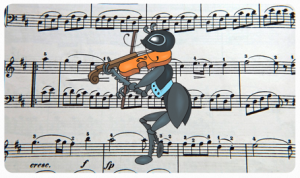
Are insects musicians? Absolutely! If we use the same general criteria we use for humans, i.e. the creation of a coherent sound which may have melodic and harmonic content for some purpose, insects are definitely musicians. We admit that some taxa are better than others. Beetles, bugs, bees and butterflies are pretty good musicians although they pale in contrast to the orthopterans such as cicadas and crickets. But even termites and spiders can carry a tune. And insects produce musical sounds for a variety of different purposes: to call a mate, pick a fight, and start a chorus, among others. It should also be noted that insects are instrumentalists. That is, they make sound through the use of specialized body parts (read: instruments) that make sound. They are not vocalists that produce sound with a larynx such as is the case for humans and some birds.
One might argue that the aforementioned purposes are utilitarian goals on the part of the insects, not aesthetic ones. And from the human perspective, that is probably a fair evaluation. But, let’s recall that humans sometimes write music for strictly utilitarian reasons, like occupying an audience during set changes or to provide a literal sound scape of an event. Thus, it would be unfair to say that insects are not musical simply because, as far as we can tell, they are not making this sound for aesthetic reasons. At this point, we might charitably note that insects have been at this for millions of years. Humans, on the other hand, are relatively new to the party. If practice makes perfect, insects have clearly put in more practice time.
A professional musician will tell you that music is a product not just of the sound produced but of the rests and silence that is interwoven with the notes. Insect music also has this characteristic. There are spaces between the sounds they produce and, often, there is a regular beat.
Another characteristic of good musicianship is that when producing music in a group, the musicians must listen to each other. They will adjust their sound to individuals in the performing group. This characteristic produces a unique experience each time a particular piece is performed because it is not simply a matter of reproducing the notes specified on the page. Novelty comes from interpretation and incorporation of the unique character of each musician to the group effort.
We know that insects do listen to each other when making sound. Insect musicians are communicating a message as they sing. We know that insects (at least those of the same species) that hear the music understand the message. We don’t know if the recipients adjust the sound they make in response to the insect producing the sound. Often, the recipient of the sound message does not respond by singing, but his or her behavior will demonstrate that the message has been received.
For millennia, humans have used music for spiritual and religious purposes. One event that is part of spiritual practice for most human religions is to use music to honor and observe the passage of seasons. Insects do this too. When we hear the chirp of a cricket or the drone of the cicadas, we know that summer has arrived. In this way, insects help bind humans to the natural world. The notion that insect music could redirect attention to natural phenomena is an intriguing one—to us at least.
Another intriguing aspect of insect-produced sound is that they have discovered so many methods for doing it. They can drum on solid surfaces, force air through small holes, draw a file across a scraper, or make sound in several other ways. This is analogous to humans who have found diverse ways to produce and manipulate sound as well. Both humans and insects, we would argue, are artists of sound.
Finally, insects can create sound that takes on some of the structural components found in human music. In some key groups, there is a well-defined evolutionary sequence in sound production over time that underscores both the versatility of sound production in insects as well as its importance throughout the lifecycle. At the more primitive end of the spectrum, using very primitive orthopterans (grasshoppers, katydids and crickets) as an example, some grasshoppers make sounds that have been described as cackles or lisping. They do not use specialized sound production organs to do this. There also can be considerable variation in the nature of sound made while in flight. For instance, some grasshoppers in the genus Arphia make a clattering sound while other species make sort of a swooshing sound. Still others create noise while hovering.
More advanced orthopterans do use specialized organs such as a rasp and file to make music. The equipment can be, and is, located on virtually any two body parts that are in close enough proximity to each other to allow the parts to scrape each other. What is fascinating about the crickets and, in fact, distinguishes some of them from less advanced forms is that one can identify different tones among the notes played by the crickets. This is to say that some species produce notes with an identifiable pitch. Still, even those with a discrete tone tend to be “Johnny One Notes.” But, their musical compositions vary, nonetheless, because the advanced orthopteran musicians can combine tones into trills, interject rests between notes, and vary the level of sound produced either individually or by singing in groups.
Can we really argue that insects have an aesthetic sense? Honestly, who can really know the mind of an insect? Based on what we do know, we cannot categorically rule out the notion that insects may, in some circumstances, be creating sound because it is beautiful to them. Since a lot of insects use sound as a device for attracting a mate, we must certainly allow that those insects have romantic intentions even if it doesn’t involve wine and roses. And we know that different groups of even closely related insects produce distinctly different sounds. It is similar to the reality that different human societies value different scales, tones, and intervals. Insects, too, may have such preferences. Still, the underlying impetus to produce this sound is almost certainly instinctive and not the result of learning or choice.
Even so, I come away from this discussion with the notion that insects produce sound that is much richer than simply making noise to attract a mate or defend its territory. We may one day discover that insects manipulate sound in ways we would consider original.
What is Sound
To understand insects’ musical talents, it is useful to review exactly what both musical and nonmusical sound is. Sound is merely a form of energy that is transmitted through some medium—usually air or water. Sound is created in waves through vibrations, and because sound is a wave function, it has standard characteristics of a wave-like frequency (number of waves per second) and amplitude (the intensity or volume of the sound produced).
The musical genius of insects is revealed in the large number of mechanisms they have to produce sound. These include stridulation, tymbaling, drumming or tapping on a substrate, vibrating their wings or body parts in air or water, and forcibly ejecting fluid or air out of their bodies. We’ll go over each of these in more detail and with examples in the next section.
Function of Sound
But before we begin our discussion of the different types of insect sounds, let’s take a brief detour to consider the functions of sound production in insects. We will discuss the insect-themed music that humans produce in Chapter 10. For now, though note that some music produced by humans has a literal or utilitarian function. This is especially true when humans try to imitate insect sounds in movies, plays and operas to create a soundscape or sense of where the audience is in space and time. Specifically, the music tries to capture the actual sound that insects produce. There are also a lot of examples of metaphorical uses of sound by insects, where the insect sound was supposed to represent another idea or a habit of the target insect, e.g., metamorphosis. Additionally, there is a good deal of insect-themed music that had a strictly aesthetic purpose.
When we turn to the music that insects themselves produce, however, we normally are typically looking at very pragmatic goals. The sounds produced by insects may have specific functions critical to the survival of the species, such as reproduction, repellence, defense, or the gathering of food. There is also a subset of sounds that are unintentional and are byproducts of other activities of the insect. These are termed incidental sounds.
Stridulation
Let’s begin with a look at stridulation—the most common form of sound production among insects. This type of sound is produced by rubbing two structures, the file and the scraper, together. This is what produces the distinctive (and sometimes irritating) sound of the cricket’s chirp. Take a listen by following the link to the YouTube video (Video 9.1). This lovely male is stridulating to produce the sound that we associate with having our sleep interrupted, and he associates with love.
Stridulation is very common throughout the insect order Orthoptera in both larvae and adults. Ants can also stridulate. In fact, ants use a variety of sound to communicate with each other. Some ants are able to use a file and scraper located on their abdomen (or gaster) to stridulate (Figure 9.1). This is particularly useful to ants that live underground. From time to time, the ants get buried and will stridulate to attract worker ants to extract them. Ants are not the strong, silent type after all! Even more interesting, there are beetles that can invade the ants colonies and they also appear to mimic the ants stridulatory sounds (Video 9.2).

Also known for being devoted to stridulation as mode of sound production are the insect orders Lepidoptera (butterflies and moths), Coleoptera (beetles), and some Hemiptera (true bugs). The basic stridulatory apparatus has undergone great modification among the different insect orders that use stridulation, and may be found on many different body parts in immature and adult forms. The function of the sound produced by these diverse insects serves diverse ends, including attracting a mate, sounding an alarm, defensive noise, and more. One question that arises when we consider all of this sound is why aren’t humans even more aware of insect sound? The answer is, in part, that the sound produced by many insects is at too high a frequency to be detected by the human ear. Thus, we are spared hearing a lot of the ambient sound generated by insects unless we are armed with special equipment.
To further assist our analysis of insect-produced sounds, we can also think of each sound as an analogy to instruments played by humans. Stridulation, for instance, is similar to sound production with a violin and bow. To make the analogy work, you need to know that a violinist will coat her bow hairs with sticky rosin, which helps the bow grab the strings, and the friction produced by the drawing of the bow across the strings creates the sound. In insects, this type of sound requires some morphological adaptations. In crickets and katydids, the file and scraper are found on the edges of their wings. The sound is then produced by rubbing the wings together. Some Coleoptera, in contrast, have the relevant parts on their legs, whereas others put them on their mandibles. Ants are versatile and may have the sound producing organs on their abdomens or mandibles. Lepidoptera can put scrapers and files on their legs, or in the case of larvae, the mandibles. It would be pretty cool to see a violinist playing with his mouth!
Tymbaling
Another sound production mechanism is tymbaling. Tymbals, not to be confused with tympana which are used for sound reception, are rigid internal structures whose function is to produce sound. These are less widely used among insects and are found primarily in cicadas and other related groups. The tymbal consists of a tymbal plate that contains a series of large and small ribs (Figure 9.2). Strong muscles located in the tymbal cause the ribs inside the tymbal to collapse in sequence (video 9.3). As each rib collapse, it makes a clicking sound. In the sense that ribs are involved in the sound production, tymbaling is similar to stridulation except that the tymbal is borne internally rather than on an outside body surface. In cicadas, the tymbal is used by males to call to prospective mates—and disrupt your sleep in the summer.
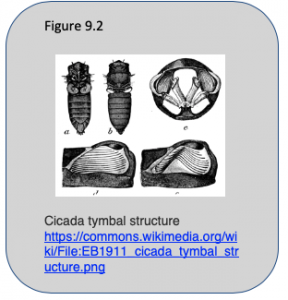
As you know from your experiences with cicadas, tymbals can produce sound that is very very loud (video 9.4). The females will use the call to locate males of the same species within a population of mixed species. It certainly appears that each male is doing his best to drown out the sounds produced by competing males. In fact, cicadas can reach a 120 decibel level, which is high enough to cause pain in the human ear. Interestingly, small cicadas create a pitch that is too high for humans to hear, but it can be heard by dogs, and is sometimes a source of discomfort for our canine friends during the so-called “dog days” of summer.
Percussion
Next we move on to percussion—insects are great percussionists! In a sound production modality that is similar to a drum, insects are adept at using body parts to drum on a surface. Beetles often use their heads for this purpose. Cockroaches are able to tap and drum with their abdomens. Plant hoppers and stink bugs can actually transmit drumming sounds, not through air or water, but through plant material—sort of like tying two cans together with a string, speaking into one can, and having the string transmit the sound waves to the other can. In this video on Youtube (Video 9.5) a very romantic spider taps his heart out on a substrate in his quest to win his lady-love. He’s definitely got rhythm, but she’s definitely not interested. Sadly for him, she is actually a pinned specimen that is no longer alive. He still tries his best, though.
Buzzing
Some insects have the regrettable ability to produce sound by moving air with their wings or wing muscles to create a buzzing sound. In terms of human music, this is similar to how reed instruments work. And, of course, it is the method of choice of our good friend the mosquito whose sound production can disturb our night time reverie with its annoying, high-pitched whining noise. The mosquito could not care less about us—except as a source of blood. The sound production is one of those aural mating cues we’ve been discussing. Mosquitoes can even sing duets in which males attempt to match the frequency of the female he is courting (video 9.6). Now that is love! Bees also use the buzzing sounds produced by the queen—more of a piping and quacking sound actually—to communicate with the rest of the hive.
Other Sounds
A final way for insects to make intentional sound is to force air or a body fluid through a small space, resulting in hissing, popping, or squeaking noises. Continuing with our analogies with musical instruments that humans use, a brass instrument where air is forcibly blown into a constricted space comes to mind. The types of body holes used by insects for this purpose are various and include the spiracles, the mouth, and the anus. Perhaps the most well known example is the hissing cockroach, which forcibly expels air through the first pair of spiracles as a very effective defensive measure (video 9.7). Some caterpillars make a more cute and squeaky noise (video 9.8).
Bombardier beetles keep two noxious chemicals (hydroquinone and hydrogen peroxide) produced by separate glands in separate locations. When the beetle is threatened, the two chemicals are mixed, causing an exothermic reaction that results in the chemical mixture bursting forth from the anus accompanied by a loud pop. If the sound doesn’t scare potential predators, the unpleasant chemicals definitely will (video 9.9)!
Finally death head moths make use of their mouths as a defensive ejection port. When disturbed, the moth forces air through its mouth creating a loud squeaking sound (video 9.10). When accompanied by the flashing of its wings and exposure of the death head on its thorax, it can be quite intimidating to even humans.
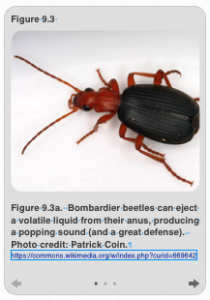
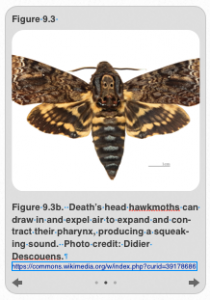
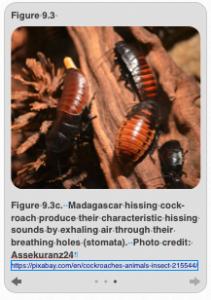
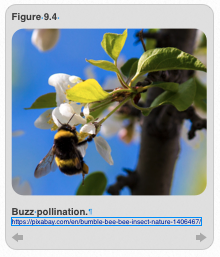
Sometimes insects make sound without specifically intending to. This is referred to as incidental sound caused by the movement of body parts in the course of getting around. It is produced by many species using many different methods (Figures 9.3a, 9.3b 9.3c). The buzz of the honey bee is a good example. We infer changes in mood by the pitch of the buzz with anger being attributed at a higher pitch or more cycles per second. There can be important ecological consequences to this activity, such as the incidental pollination of crops. The buzzing activity of bees, for instance, may inadvertently cause pollen to fall of the anthers of a plant resulting in pollination of the plant species (Figure 9.4). Solitary bees are particularly good at grabbing the anther and using its flight muscles to vibrate the anther enough to release the pollen, a process aptly named “buzz pollination.”
Sound Modification
Insects are also geniuses at conducting music. Often, insects are able to modify the kind of sound produced by employing elements of the environment to change the sound. In these cases, structures in the environment function like musical instruments with the insects as the conductors.
An example of this is the “baffle” which functions like a tiny speaker box. The baffle, which can be created from something as simple as a leaf, is a technique honed to perfection by tree crickets. What the baffle does is to cause sound waves to advance in phase which amplifies the sound. In contrast, if the waves are 180o out of phase, they cancel each other out; and if two different waves are issued, a third type of wave is formed. The baffle creates in-phase waves with minimal interference to produce a very loud sound.
In Figure 9.5a, (click link) we see two oscillograms of the tree cricket. The upper trace is produced without a baffle; the lower trace is made with a baffle (Figure 9.5b – click link). You can see that the amplitude of the wave is much greater, indicating a louder sound.
Although singing underground, the mole cricket has figured out how to use its environment to amplify its sound for the purpose of attracting a mate. Take a look at the very well developed forelegs that have been modified for digging (Figure 9.6a). Using these hefty legs, the mole cricket can dig out a “singing burrow” that has at least two openings above ground. It also has a bulb. The singing burrow, like the leaf baffle, amplifies sound and also allows the sound to be produced more efficiently, and with a lower energy cost.
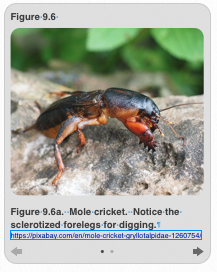
In Figure 9.6b (click the link), you see the singing burrow of a mole cricket. The first thing to note is the two openings of the “horn” above ground, and the bulb in which the head of the mole cricket is situated. Also note the top-down orientation of the male in the burrow. The male mole cricket produces sound by rubbing its short forewings together. On each wing a cell has been modified into a file or scrapper (one on each wing) to create sound by stridulation when the wings move against each other. The bulb amplifies the sound and the openings allow the sound to escape above ground should there be a female of the species on the prowl.
Sound Detection
Of course, all of this discussion about sound production begs of the question of how the insect knows that the sound is being produced. In other words, the insect can’t be attracted or repelled by a sound unless it can detect it. We, therefore, have to ask: do insects have ears?
The answer is, of course, yes!! Insects have tympana (singular = tympanum)—not to be confused with tymbals on cicadas, which like cymbals, make noise—which are eardrum-like structures that respond to vibrations, such as an approaching sound wave. Only a small percentage of all insects can hear. But, many orders of insects have tympana located somewhere on their bodies.
There is considerable variation, both in where the tympana are placed and in their structure. Tympana can be very small, consisting of a single cell, or extensively innervated with over 1,000 neurons. Vertebrates have only one type of hearing organ but in arthropods, hearing and the ability to detect sound have evolved independently at least 19 different times. Clearly, the ability to hear an approaching predator or a receptive mate is extremely important to the survival of individual species as well as to potential predator and prey species.
Moths have invested particularly heavily in tympanal organs. Why do you suppose this is? One reason is that, since they are on the wing at night, they need to be able to detect and evade flying predators like bats. Moths often have stereoscopic hearing with two or more tympana so that they can detect sound coming in from different directions, and some can even produce sounds to jam a bat’s ability to ecolocate (video 9.11). In contrast, praying mantids have only one tympanum located in the ventral midline of the thorax which makes it impossible for mantids to determine the direction from which a sound is coming. Mantids, in fact, have been described as auditory Cyclops. Interestingly, male mantids have fairly acute hearing. But females, if they can hear at all, have auditory thresholds in excess of 90 dB, which is associated with short wings.
How exactly do insects hear? The tympanate ear consists of three basic parts: the tympanum or membrane, the tracheal sac, and the tympanal organ. The tympanal membrane is an area of very thin cuticle that is capable of vibrating when it experiences a pressure differential on its two sides. The tracheal sac located behind the tympanal membrane is filled with air and offers impedance that is the same as the external environment. The vibrations of the tympanal membrane that are set in motion by air pressure changes across the membrane must be transduced into a neurological signal. This is the function of tympanal organ that contain sensilli that are stretchable in response to movement of the tympanal membrane, resulting in a neurological sound message that is processed and interpreted by the brain.
Like humans, insects are very interested in listening to conversations that other organisms are having. Yes, insects love to eavesdrop! For some nefarious insects, eavesdropping is a part of their monstrous plan to steal your body, or the body of another insect!!
Certain parasitoid flies, such as tachinid flies for instance, will follow the call of the male cricket to locate the singing male. The parasitoid then lays an egg on the cricket, which when hatched, parasitizes the male. The parasitoid larva develops in the singing cricket silencing him forever. An ignominious end to a love-struck cricket singing his heart out.
Chapter Summary
In summary, insects have used sound to great advantage in trying to earn a living in a resource-limited, and frequently hostile, environment. Insects demonstrate a host of specialized morphological structures to both make and detect sound. From an evolutionary perspective, insects are old hands at the whole auditory thing, with at least 19 separate attempts at evolving hearing. Insects have gone on to recruit the environment to help make sound production more efficient, and have even figured out how to make sound producers the victims of their own noise. It’s a noisy world out there if only you have the sense to hear it.
References
Chapter 9 Cover Photo:
Sheet music: CC0 Public Domain, Barni1. Accessed via pixabay.com
Ant playing violin: CC0 Public Domain, Clker-Free-Vector-Images. Accessed via pixabay.com
Figure 9.1: Figure 1 from: Sendova-Franks and Scott. 2012. Vibrational communication in digging ants. Animal Behavior 84(4): 739-741. http://dx.doi.org/10.1016/j.anbehav.2012.08.013. Accessed via https://www.journals.elsevier.com/animal-behaviour/featured-articles/vibrational-communication-in-digging-ants
Figure 9.2: Diagram source “The role of tymbal in cicada sound production” by D. Young and H. C. Bennet-Clark. Accessed via http://ptolentinobioresearch.wikispaces.com/file/view/cicada.jpg/77103293/643×360/cicada.jpg
Figure 9.3a: Bombardier beetle. CC-BY-SA 2.5 by Patrick Coin, own work. Accessed via https://commons.wikimedia.org/w/index.php?curid=669642
Figure 9.3b: Death’s head hawkmoth. CC-BY-SA 4.0 by Didier Descouens, own work. Accessed via https://commons.wikimedia.org/w/index.php?curid=39178686
Figure 9.3c: Madagascar hissing cockroaches. CC0 Public Domain, Assekuranz24. Accessed via https://pixabay.com/en/cockroaches-animals-insect-215544/
Figure 9.4: Bee on flower. CC0 Public Domain, dennisflarsen. Accessed via https://pixabay.com/en/bumble-bee-bee-insect-nature-1406467/
Figure 9.5a: Diagram of phasing oscillograms. Accessed via http://www.mediacollege.com/audio/01/wave-interaction.html
Figure 9.5b: Tree cricket sound baffle. Accessed via http://www.abundantnature.com/2012/08/tree-cricket-song.html
Figure 9.6a: Mole cricket. CC0 Public Domain, Hans. Accessed via https://pixabay.com/en/mole-cricket-gryllotalpidae-1260754/
Figure 9.6b: Mole cricket burrow. Diagram from Axel Michelsen and Harald Nocke, “Biophysical Aspects of Sound Communication in Insects,” Advances in Insect Physiology (New York: Academic Press, 1974), pp. 247-96. Accessed via http://www.swarthmore.edu/Humanities/pschmid1/array/convolute3/harpandmirror2.html
Video 9.1: Male cricket chirping. Available on YouTube at: https://www.youtube.com/watch?v=CQFEY9RIRJA&feature=youtu.be
Video 9.2: What sounds do ants make? Available on YouTube at: https://www.youtube.com/watch?v=yif0c0bRA48
Video 9.3: How Cicadas Sing. Available on YouTube at: https://www.youtube.com/watch?v=9ZbRWkeAW9w
Video 9.4: Cicada producing sound with tymbals. Available on YouTube at: https://www.youtube.com/watch?v=9XYcnbFqgLQ
Video 9.5: Jumping spider mating dance. Available on YouTube at: https://www.youtube.com/watch?v=A6Pu-4qzMkk&feature=youtu.be
Video 9.6: Mosquito use music to mate. Available on YouTube at: https://www.youtube.com/watch?v=CPqNyzvhz54
Video 9.7: Madagascar hissing cockroach. Available on YouTube at: https://www.youtube.com/watch?v=W7Efjt6UC1g
Video 9.8: Squeaky caterpillar. Available on YouTube at: https://www.youtube.com/watch?v=2tBCAf_72pY
Video 9.9: . Watch a Bombardier beetle mace a mantis. Available on YouTube at: https://www.youtube.com/watch?v=BBAhV4NeAnA
Video 9.10: Death head’s moth — Squeaking Sounds. Available on YouTube at: https://www.youtube.com/watch?v=fWcoMstzxcc
Video 9.11: Moth jamming bat. Available on YouTube at: https://www.youtube.com/watch?v=GZxK_0OSoFk
Additional Readings
Allard, H.A. (1928). Specializations Governing Music of Expression among Insects. The Scientific Monthly 27: 81-88.
Allard, H.A. (1920). Our Insect Instrumentalists and Their Musical Technique. From the Smithsonian Report for 1928, Pages 563-591.
Elliot, L. and W. Hershberger (2006). The Songs of Insects. Houghton Mifflin Company, Boston, New York. 227 pages.
Montealegre, Z., P.A. Guerra and G.K. Morris (2003). Panoploscelis specularis (Orthoptera: Tettigoniidae: Pseudophyllinae): extraordinary female sound generator, male description, male protest and calling signals. Journal of Orthoptera Research Dec 2003 : Vol. 12, Issue 2, pg(s) 173-181 doi: 10.1665/1082-6467(2003)012[0173:PSOTPE]2.0.CO;2
Rothenberg, D. (2013). “Bug Music: How Insects Gave Us Rhythm and Noise.” St. Martin’s Press, New York., 278 pages.
Westerkamp, H. (2001). Speaking from Inside the Soundscape. In: “The Book of Music and Nature,”
D. Rothenberg and M. Ulvaeus (eds.), Wesleyan University Press, Middletown, CT, 260 pages.
Yack, J. (2004). The Structure and Function of Auditory Chordotonal Organs in Insects. Microscopy Res. And Tech. 63:315–337.
Young, D. and H.C. Bennet-Clark (1995). The Role of the Tymbal in Cicada Sound Production. J. Experimental Biology 198: 1001-1019.